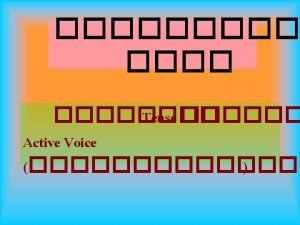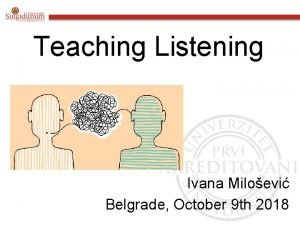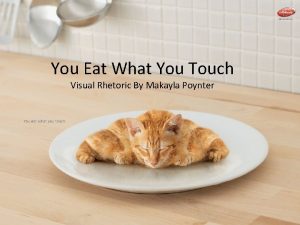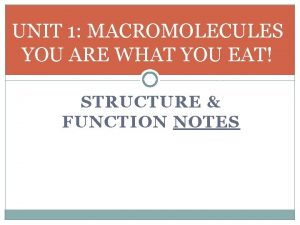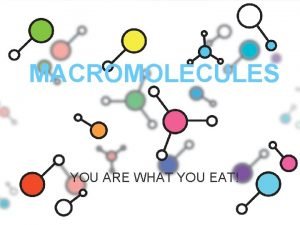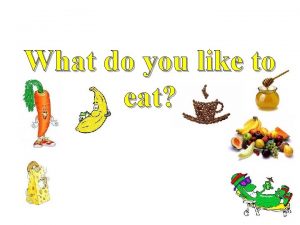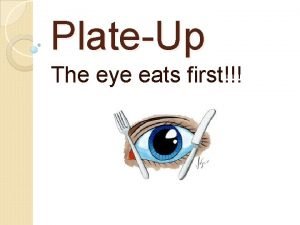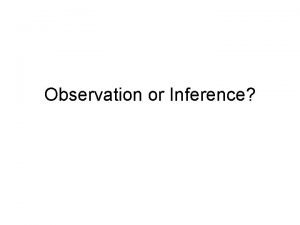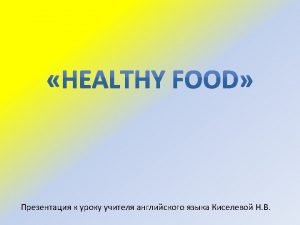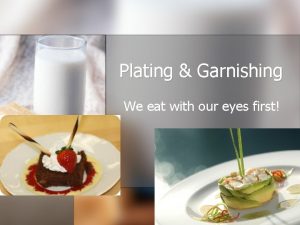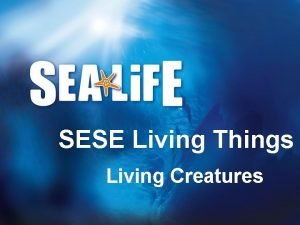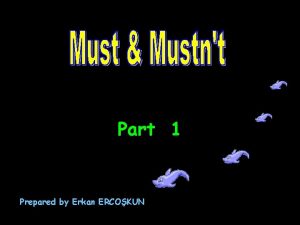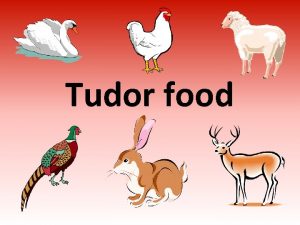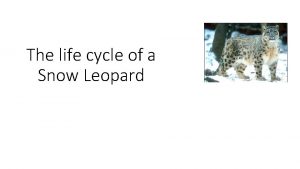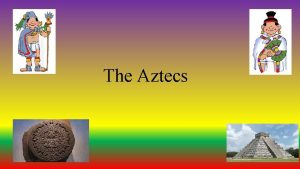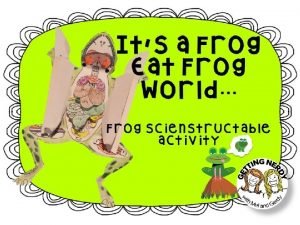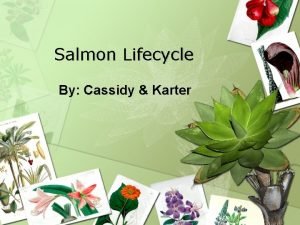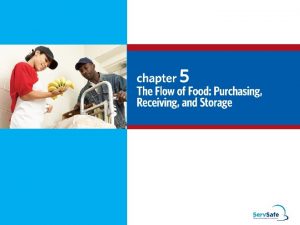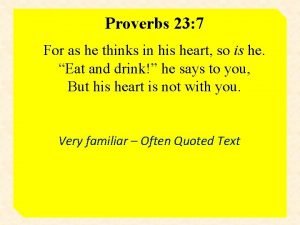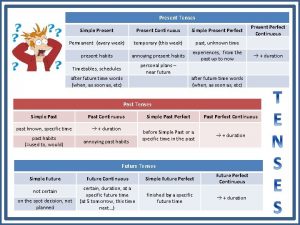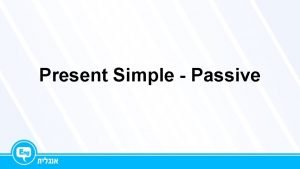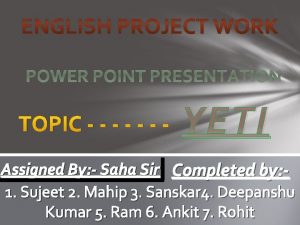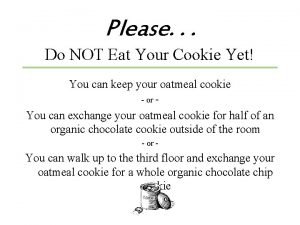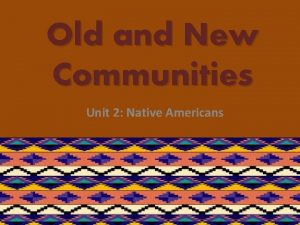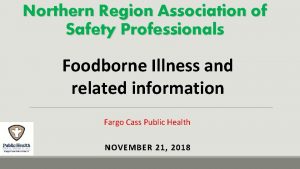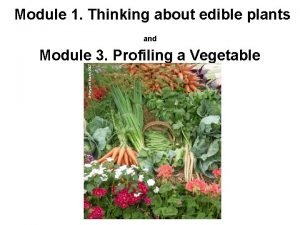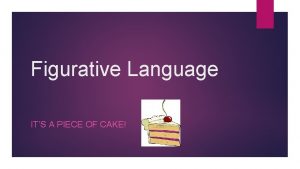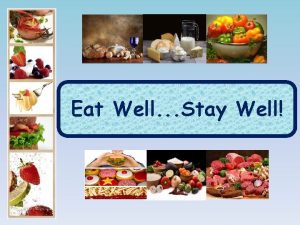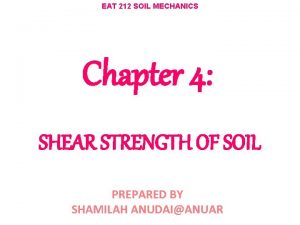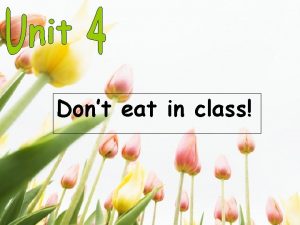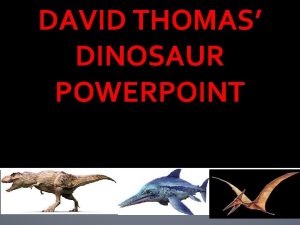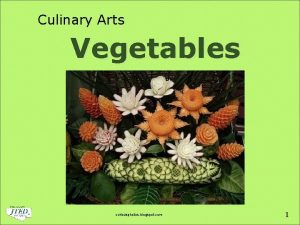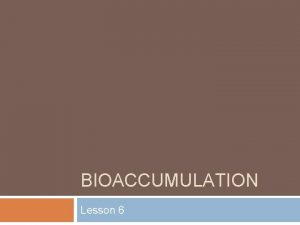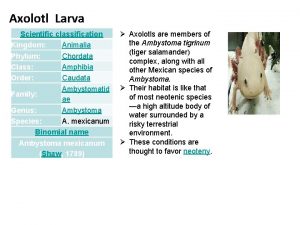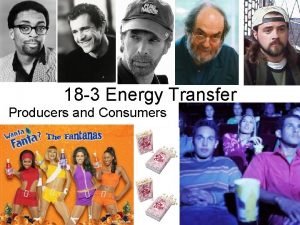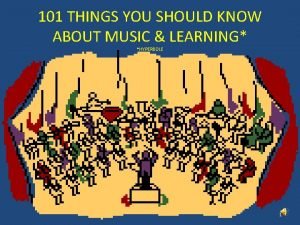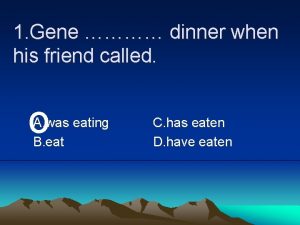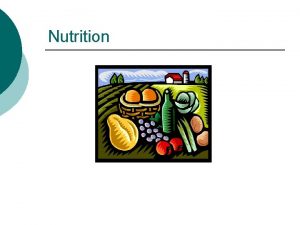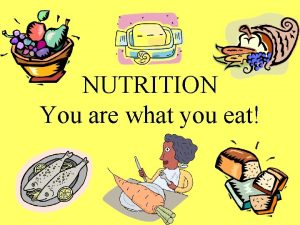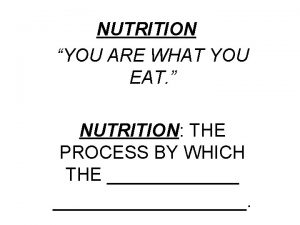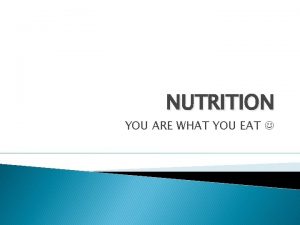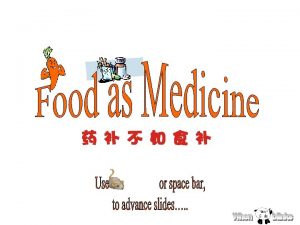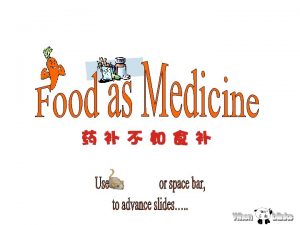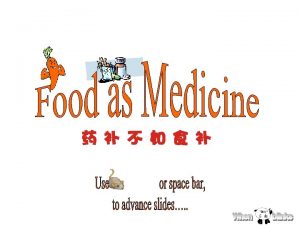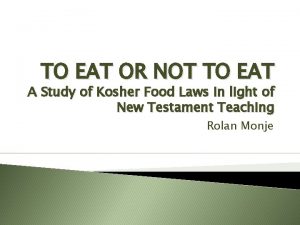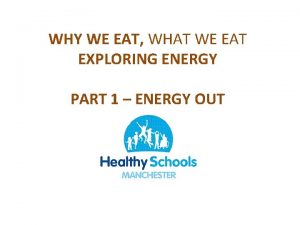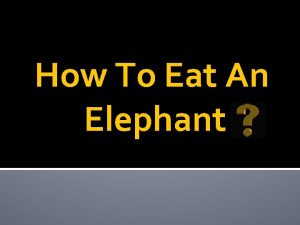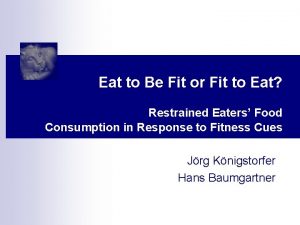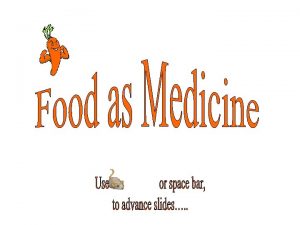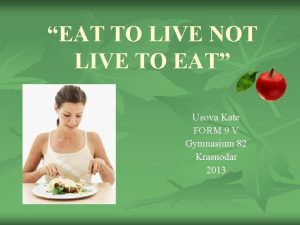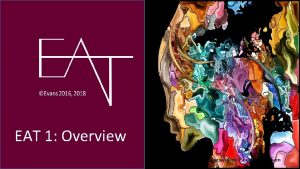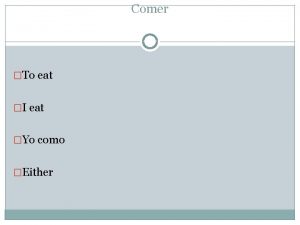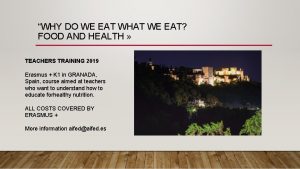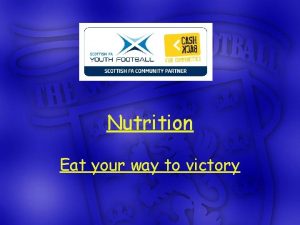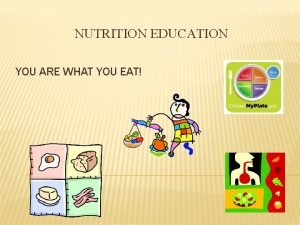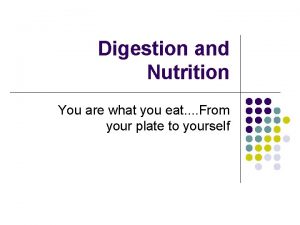Nutrition Nutrition You Are What You Eat Nutrition






































































- Slides: 70

Nutrition

Nutrition – You Are What You Eat ¡ ¡ ¡ ¡ Nutrition – Has been defined as the food you eat and how your body uses it. Nutrients – are chemical substances supplied by food that the body needs for growth , maintenance and repair Macronutrients – are carbohydrates, fats, and proteins CHO, fats are well known as fuel foods – but protein is sometimes forgotten CHO – 4 Kcal/gm FAT – 0 Kcal/gm Protein – 4 Kcal/gm

Diet & Illness ¡ ¡ ¡ Some of out nation’s top leading causes of death have been associated with diet: 1. Coronary heart disease 2. Certain types of cancer 3. Stroke 4. Diabetes 5. Atherosclerosis

Nutrition - Purpose ¡ ¡ ¡ 1. Provide energy for body processes & movement 2. Provide structural material for body tissue 3. Regulating body processes

Photosynthesis ¡ ¡ ¡ Plants with green leaves trap the radiant energy of sun & through this process, store it as chemical energy in CHO CO 2 = H 2 O + Chlorophyll = CHO ---either as a starch or sugar Plants – Such as: l l ¡ potatoes, wheat, rice = starch peas, bananas, cherries, or beets = sugar CHO (Carbohydrates) are most economical form of energy, readily accessible foods, the energy used by the brain

Simple vs Complex Carbohydrates ¡ Simple: ¡ Monosacchrides: ¡ Glucose, Fructose, Galoctose ¡ Foods: grapes, oranges, dates, honey, corn syrup ¡ Type CHO that is absorbed from intestinal tract

Simple CHO ¡ Disacchrides : Double sugar ¡ Succose, maltose, lactose ¡ W & B Sugar, molasses, honey, sweet potatoes, pineapples, carrots

Complex CHO ¡ Polysaccharides ¡ Starches ¡ Fiber -

Complex - Polysaccharides ¡ ¡ ¡ Starches – Large molecule of glucose Requires longer to digest Glucose available slower Ex: Cereal grains, corn, peas, potatoes, squash, legumes Starch increases with maturity

Fiber ¡ ¡ Cellulose Absorbs water to provide bulk or roughage in diet Bulk stimulates peristalsis Cellulose is undigested

Dietary Fiber 20 -35 g/day ¡ ¡ ¡ Soluble: Able to dissolve in H 2 O Beans, oatmeal, barley, broccoli, citrus fruits Regulate blood glucose level Weight loss Lowers cholesterol

Dietary Fiber ¡ ¡ ¡ Insoluble: Incapable of being dissolved Fruits and veg. skins, nuts, popcorn Promote bowel regularity Decreases risk diverticular diseases, cancer

Circulating Blood Glucose ¡ 40 mg/dl - 80 -- 120 - 160 - 180 --- 500 Hypoglycemia ¡ Body secretes ¡ Hormones i. e. ¡ Epinephrine, Growth *Glucagon ¡ Glucose Exceeds Renal threshold Glucosuria Insulin is secreted from Beta cells of Pancreas to< BGL

Circulating Blood Glucose (con’t) ¡ ¡ *Glucagon (Job is to increase BGL) Is secreted by alpha cells of pancreas Stimulates the breakdown of glycogen & release of glucose by the liver > increases blood sugar levels That’s why if you are hungry @ 10 -11 am you will be able to wait until 1 pm or so to eat

Circulating Blood Glucose (con’t) ¡ ¡ ¡ ¡ ¡ Glycogen: Is a polysaccharide Is stored in liver & muscle tissue (called animal starch) Is a string of glucose. 50 -75 gm of glucose is stored in the liver as “hepatic glycogen” An adult male has 300 gm stored in the liver & muscles An important link in energy metabolism: Helps sustain normal blood sugar levels during fasting periods such as sleep hours Provides immediate fuel for muscle action especially athletic activity.

Digestion of CHO ¡ ¡ ¡ ¡ Mouth -> chewing food particles ->mixes with Saliva (Salivary Amylase) > changing dextrins & maltose Stomach – Mixing continues > Thicker > Chyme Small Intestines – With aide of: Pancreatic Amylase & Intestinal Secretions > conversion from complex to simple sugars From small intestines -> 1. portal circulation to liver to be converted to glucose & then glycogen & Stored 2. To blood stream to all cells for Energy 3. Or stored as Fat

CHO: Signs & Symptoms of Inadequate CHO Intake ¡ ¡ ¡ ¡ 1. Fatigue 2. Dehydration 3. Energy Loss CHO are stored for around 24 hours *If CHO are lacking then: 1. Protein catabolism begins only after a few hours rather than using protein for healing 2. Fat tissue is broken down with release of fatty acids, glycerol & ketone bodies which means fats burn incompletely & acidosis occurs. *Glucose is required for complete oxidation of fats.

CHO: Signs & Symptoms of Inadequate CHO Intake (con’t) ¡ ¡ ¡ As long as glucose is present, ketones are quickly metabolized by muscle tissue so that ketone levels of the blood remain unchanged. Pts. with Ketoacidosis have excessive ketone bodies in the blood. They exhibit hyperventilation, loss of Na, K+, Cl- and H 2 O form the body. Excessive glucose is converted to glycogen until this limited glycogen storage capacity is filled (50 -75 gm) simultaneously glucose is also converted into fats & stored as adipose tissue.

Normal Blood Glucose Level: 80 – 120 mg/dl Factors that affect how much CHO are available for the body to use: ¡ 1. State of mucous membrane of GI tract: l l ¡ 2. Hormones: l ¡ i. e. : intestinal disease or hypermotility (Diarrhea) This limits or alters contact with CHO to intestinal wall for absorption i. e. : Insulin, Glucagon (from pancreas) & epinephrine (from adrenal glands) 3. Vitamins: especially “B” complex are involved in the metabolism of CHO l l B 1 – Thiamin, B 2 – Riboflavin, B 3 – Niacin *** Remember TRN 123 Temporary Registered Nurse

¡ ¡ ¡ CHO are Protein sparing: l If CHO are present in adequate amounts you don’t use protein for energy. Need 100 g/day to prevent this CHO’s prevent formation of ketones (Ketoacidosis): l if CHO decreased (starvation, diabetes) l excess fat is oxidized and therefore increases ketones

Energy from CHO is in the form of: ¡ ¡ Heat Muscle contraction Synthesis of essential compounds Conduction of nerve impulses

Health Problems & CHO’s ¡ ¡ Dental caries Obesity Hypoglycemia/ Hyperglycemia Alcohol blocks glucose production by the liver

Lipids -- Fat ¡ ¡ Classified According to three Criteria: 1. Whether the fat is emulsified or nonemulsified 2. Visible or invisible 3. Simple or Compound

Lipids – Fat (con’t) ¡ ¡ ¡ The term Emulsion is applied to a liquid dispersed in another liquid with which it does not usually mix. i. e. : Oil and Vinegar do not mix Fat is insoluble in H 2 O A means of transporting fat thru the water based blood is a problem. So the body must emulsify dietary fat. This occurs in the small intestine thru the action of bile salts (from liver to GB)

Visible vs. Invisible ¡ ¡ ¡ ¡ ¡ Visible Fat: 40% Easily seen on meat Oil Butter Invisible Fat: Hidden in foods Egg yolk Baked goods Snacks Emulsified milk Cheese Olives Nuts Avocados

Simple vs Complex Lipids in foods and in the human body fall into 3 classes: ¡ 1. Triglycerides (simple) – 95% ¡ 2. Phospholipids – ex. Lecithin ¡ 3. Steriods – ex. Cholesterol ¡ Blood lipids, cholesterol, fats & oils all contribute to health and detract from it. ¡

Fats Provide: 1. Energy – for now & stored fat for later energy ¡ 2. Insulation – Maintaining body temp & padding (protecting organs) ¡ 3. Cell membrane integrity ¡ 4. Nerve impulse transmission ¡ 5. Carries fat soluble vitamins (ADEK) ¡ Taste (satiety) – Adds texture & flavor to foods ¡

Usefulness of Fats ¡ ¡ In Foods: l Makes foods taste better l Taste, smell, feel full l Provide essential fatty acids l Provide energy l Carry fat soluble vitamins In Body: l Insulation l Padding l Energy l Cell membrane material

Fatty Acids Saturated: Unsaturated: ¡ One whose Has at least one structure is unfilled H+ spot completely Monounsaturated filled with all vs H+ it can hold Polyunsaturated ¡ Heavier, more The more unsat. dense, more solid the more liquid ¡ Requires higher at room temp. Temp. to melt ¡

Monounsaturated Fatty Acid ¡ ¡ Usually Plant Origin Liquid at Room Temp Can Become saturated if a chemical change occurs Foods: Peanuts, Peanut oil, Olives & Olive oil, Almonds, Pecans, Canola oil

Polyunsaturated Fatty Acids ¡ ¡ ¡ ¡ Plant Origin Liquid at Room Temp. Foods: Veg. Oils Sunflower oils Some margarines French Dsg. Walnuts

Trans-Fatty Acids ¡ ¡ ¡ Have implications for the body’s health Not currently mentioned on food labels Carry a risk similar to saturated fats Elevated blood cholesterol & thus raise the risk of heart disease & heart attack Are found in fast foods, chips, baked goods, & other commercially prepared foods High in fats can contain up to 50% trans-fatty acids

Chemical Digestion Fat Begins ¡ ¡ Mouth -> via chewing -> smaller parts & warms food Stomach -> Fats emulsified due to Gastric lipase & peristalsis Small Intestine -> l Bile Salts: Fat in duodenum -> releases of cholecystokinin > causes GB to contract > releases bile ¡ Bile: 20 -60 ml held in Gallbladder, produced in liver l Enzymes: pancreatic lipase & enteric lipase End Products: Monoglycerides, Fatty acids, Glycerol

Blood Lipid Profile ¡ ¡ ¡ Triglycerides: <100 mg/dl desired Cholesterol: <200 mg/dl 200 -239 Borderline CVD. > 240 ^ risk Lipoproteins: HDL – High density – good 29 -77 mg/dl Carry cholesterol away from cell LDL Low density – bad 62 -185 mg/dl Carry cholesterol to cell

The Good , Bad & The Ugly Cholesterol ¡ ¡ ¡ ¡ Important in structure of brain & nerve cells Nonessential nutrient Endogenous supply 1000 mg/day Take in more > Body makes less Major contributor of plaque <200 mg/dl Keep intake <300 mg/day

Cholesterol – Food Sources ¡ ¡ ¡ ¡ Egg Yolk Organ meats (especially liver & kidney) Cream Butter Ice Cream Cheese* ( The lighter in color the lower the amount of cholesterol) Remember – if it had or has a heart beat, it has cholesterol

What about Fat Substitutes? ¡ ¡ ¡ “O’lean”, Olestra O’lestra: is indigestible therefore the body has no way to take it apart Problems: causes digestive distress & nutrient losses i. e. : gas, diarrhea, cramping, strong “urge to go” Oil can leak thru feces & leak from the anus May interfere with absorption of fat soluble vitamins

Proteins – The Most Expensive Nutrient ¡ ¡ ¡ Proteins are the building blocks of blood and bone & all other tissues. They are the structural part of every cell. They are made up of smaller building blocks called amino acids. Found in scar tissue, hair growth, blood albumin, Hemoglobin

More on Proteins ¡ ¡ ¡ Chemical elements – C, H, O 2 & Nitrogen Linked together by peptide bonds 50, 000 different proteins 24 Amino Acids Change the number or arrangement you change the Amino Acid Essential vs Nonessential

4 Major Functions in Body ¡ ¡ 1. Maintenance of Growth 2. Regulation of Body Process 3. Development of Immunity 4. Energy

Amino Acids ¡ ¡ ¡ ¡ Essential: Means they cannot be manufactured by body & must be obtained from food 9 All 9 must be available simultaneously & in sufficient quantities for synthesis of body proteins Nonessential: Can be synthesized by body Often derived from other amino acids

Complete vs Incomplete Protein Foods ¡ ¡ ¡ Complete: Have all 9 Essential Amino Acids Examples: Meat, Eggs, & Milk Incomplete: Lack some Amino Acids Some foods mixed together = a complete protein food Examples: Corn & peas Spaghetti Noodles & cheese Milk & cereal Rice with pork Noodles with tuna

Keeping a Positive Nitrogen Balance ¡ ¡ Protein Balance: The body’s tissue proteins are constantly being broken down into amino acids, a process called catabolism & the resynthesized into tissue proteins as needed , a process called anabolism. To maintain Nitrogen balance, the Nitrogen containing element of the amino acids can be removed by a process called deamination – converting to ammonia (NH 3) & the Nitrogen is excreted as urea in the urine.

Keeping a Positive Nitrogen Balance (con’t) ¡ ¡ A positive nitrogen balance exists when nitrogen intake exceeds output, that is when protein anabolism exceeds protein catabolism. A negative nitrogen balance exists when nitrogen output exceeds intake. This state usually occurs when a person does not consume adequate essential amino acids & or calories, is immobilized, or is exposed to unusual stress as a result of trauma. To prevent this a person must ingest at least 20 -30 gms of protein each day.

Protein Metabolism ¡ ¡ ¡ ¡ ¡ Mouth -> chopping into smaller parts Stomach -> Chemical digestion begins with help of: Pepsin, HCL, & Rennin Small Intestines -> Digestion is completed here Pancreatic Secretions: Intestinal Secretions: Ex: Tryosin Ex: Ainopeptidase Chymotrypsin Dipeptidase Carboxypeptidese Absorption occurs thru lining of small intestines with help of Na End Products: H 2 O – Urea – CO 2 > Liver

Lab Values - Protein ¡ ¡ Albumin accounts for >50% of total protein & therefore reflects the protein status of blood & organs. Albumin levels: 3. 5 -5 g/dl or 35 -45 gms Albumin levels increase & decrease slowly therefore when decrease serum albumin is seen associated with malnutrition, it reflects prolonged protein depletion. Other conditions that show decreased albumin levels are, liver & kidney disease, AIDS, Ca, & burns.

Daily Allowances of Protein ¡ ¡ ¡ Based on age & desired weight Newborn: 2. 2 gm/kg 7 -10: 1. 2 gm/kg Adolescent: 1 gm/kg Adult: 0. 8 gm/kg A man weighing 154 lbs. = 56 gm of daily protein Food examples: 7 inch carrot = 1 gm protein 1 small raw tomato = 1 gm of protein Egg = 6 gm of protein Meat = 7 gm/ounce Milk = 9 gm/cup

Water – H 20 ¡ ¡ ¡ ¡ Must be consumed often & in greater quantities Solvent in which chemical reactions occur Medium for transporting substances. Ex: Blood, Lymph, Waste Provides lubrication. Ex: Synovial fluid & mucous Contributes turgor to cells Regulates body temperature via Evaporation Which food are high?

Micronutrients - Vitamins ¡ ¡ Fat Soluble: A, D, E, K l Stored in the body l Stable in heat l No nitrogen l Require bile for absorption l Soluble in fats Water Soluble: C, B Complex l Soluble in water l May be affected by cooking methods l B Complex contain Nitrogen l Very little stored therefore

Minerals ¡ ¡ ¡ Minerals, or elements: are inorganic substances Required in small amounts Cannot be synthesized in the body, must be obtained from food Some are important constituents of bones (Ca), others are required to activate specific enzymes involved in chemical reactions, to maintain acid-base balance (Mg, P, Na, Cl) & water balance (K, Cl) & muscle functions (Mg, K, Na, Ca). Approx. 3 -6% of the body weight is made up of minerals (ash). Minerals should be supplied daily because they are excreted every day by the kidneys, bowel, & skin. Minerals are stored!

Minerals (con’t) ¡ ¡ ¡ Minerals are found in organic compounds or inorganic compounds & as free ions. Upon oxidation, minerals leave an ash, which can be acid or alkaline. Ca & P make up 80% of all mineral elements in the body. There are 2 categories: Macrominerals: These are minerals people require daily in amounts> 100 mg. Ex: Ca, P, Na, K, Mg, Cl Microminerals: are those that people require daily in amounts < 100 mg. Ex: Fe, Zn, I, F.

Nutrition ¡ ¡ Nutritional status is determined: By what & how much the individual eats By his or her’s body ability to use nutrients By the state of the person as a result of the intake of nutrients

Consider the following when assessing Nutritional Status ¡ ¡ ¡ 1. Anthropometric measurements: Ht, Wt, Skin folds, Arm Circumference 2. Dietary History 3. Clinical signs of poor nutrition 4. Energy Level 5. Factors Affecting

Caloric Requirements Vary R/T Age & Growth: Growth > calorie ¡ Sex: Men have ^ BMR due to muscles, Pregnancy ^ ¡ Climate: Colder > BMR ¡ Health/Illness: ^ Temp. = ^ BMR, Malnutrition = Decreased BMR ¡ Sleep ¡ Type food consumed ¡ Activity - ^ = ^BMR ¡

Factors Affecting Eating ¡ ¡ ¡ Culture Religion Socioconomic Personal Preference – Childhood Emotions Health

Religious Considerations ¡ ¡ Jewish: Don’t mix meat & dairy products at the same meal Prohibited Foods: All products obtained from pigs: i. e. : pork, bacon, ham, animal shortening, marshmallows (gelatin)

Religious Considerations (con’t) ¡ Catholic: l l ¡ Seven-Day Adventist: l l ¡ Prohibited Foods: Pork products & shellfish Alcoholic beverages Church of Jesus Christ of the Latter-Day Saints (Morman): l ¡ Abstain from eating meat & from eating between meals on Ash Wednesday & Good Friday Observe periods of fasting Alcoholic beverages Christian: l Alcoholic beverages

Do You Know Your Numbers? ¡ Calculate BMI: l Take Wt x 704 = A l Take Ht inches x Ht inches = B l A divided by B = BMI ¡ Ideal -> 20 – 25: l Lowest risk for obese diseases (CV, Diabetes, & Stroke) 25 -30: Overweight > 30: Obese (Increased risk for the “ 3”) ¡ How about IBW ¡ ¡

Nursing Interventions to Encourage Nutrient Intake Assess situation: Foods, History, Health Issues, etc. ¡ Provide Foods they like ¡ Consult with Registered Dietician ¡ Environmental Changes ¡ Consider Medical Treatment: Meds around meals ¡

Food Pyramid Guide ¡ ¡ ¡ MILK Products: 2 -3 *Serving is 1 cup (8 oz) FRUIT: 2 -4 VEGETABLES: 3 -5 BREADS & CEREALS: 6 -11 MEAT/FISH: 2 -3 * Serving is 2 -3 oz.

Factors to Consider When Planning a Meal Include all of the food groups ¡ Variety: Color, Texture, Flavor, Shape, Satiety, *Don’t overemphasis one food group ¡ Sociologic & personal preference ¡ Time & Energy ¡ Appearance ¡ Economical fuel usage ¡ Food cost ¡

Common Therapeutic Diets ¡ ¡ ¡ ¡ Regular Liquids: Full vs Clear Soft Low Residue Low Fat Low Carbohydrate Diabetic

Calculating I & O: Do You Know Your Sources? ¡ Intake: l l l l Oral Fluids: H 2 O, Coke, Tea Ice chips Food (Liquid @ room temperature) Tube Feedings IV Fluids Irrigants Blood

Calculating I & O: Do You Know Your Sources? (con’t) ¡ Output: l Urinary l Vomitus l Liquid Feces l Tube Drainage l Wound Drainage l Fistula Drainage l Rapid Respirations l Diaphorsis

Parenteral Therapy ¡ ¡ ¡ ¡ Intake Equipment: IV Bag Drip Chamber Tubing Roller Clamp *Dial-a-Flow *Infusion Pump

Ways to control Volume of Fluid to Patients IV Pumps ¡ Solusets ¡ Dial-a-Flow ¡ Setting the correct rate on the pump ¡ Counting the number of drops in the drip chamber ¡ Assessing the patient frequently ¡

Complications from IV Therapy ¡ ¡ ¡ ¡ Hematoma: Collection of blood Phlebitis: Inflammation of vein Infiltration: Seepage of fluid into the tissue rather than vein Prevention: Frequent assessment Antiseptic ointment at site Changing lines per hospital protocol ( q 72 hours)

Insertion of a Nasogastric Tube for Suction or Feeding ¡ ¡ ¡ Have you collected ALL your supplies? What position do you need to place your patient? High Fowlers Which nostril should I use? How far do I insert the tube? Measure During insertion: l What do I tell my patient. l What should they be doing? l What technique should I be doing? Do they stay in the same position the whole time?

The Tube is in, Now what do I do? ¡ ¡ 1. Check for placement, but how? l A. Instill 10 cc air while you listen. l B. Aspirate stomach contents & check the p. H l C. Chest X-ray if possible. 2. Be sure they can speak. 3. Secure with tape to nose & provide comfort measures. 4. Connect to feeding or suction.

p. H of Secretions Yellow-Green: is p. H of 1 -4 = Acidic in Gastric Secretions ¡ Golden Yellow: is p. H of 6. 5 = Intestinal Secretions ¡ Color change toward blue: Is p. H 7. 0 -8. 0 = Lungs and a more alkaline p. H ¡
 Antigentest åre
Antigentest åre I eat, you eat, he eats
I eat, you eat, he eats Parellel structure
Parellel structure People buy me to eat but never eat me what am i
People buy me to eat but never eat me what am i You are what you eat do you agree or disagree
You are what you eat do you agree or disagree Tell me what you eat and i shall tell you what you are
Tell me what you eat and i shall tell you what you are You eat what you touch
You eat what you touch Victory in jesus images
Victory in jesus images You are what you eat macromolecules
You are what you eat macromolecules Biological molecules you are what you eat
Biological molecules you are what you eat Objective of digestive system
Objective of digestive system Why does atticus ask ewell to write his name
Why does atticus ask ewell to write his name Kate likes to eat an ice cream
Kate likes to eat an ice cream The eye eats first
The eye eats first Are sewer lice edible
Are sewer lice edible Favorite food answers
Favorite food answers You eat with your eyes first
You eat with your eyes first What do you like to eat
What do you like to eat You mustn't eat in class
You mustn't eat in class Eat sleep console scoring sheet
Eat sleep console scoring sheet Rich tudor food
Rich tudor food Touching spirit bear chapter 10 summary
Touching spirit bear chapter 10 summary Volvox eat
Volvox eat Longest food chain
Longest food chain Life cycle of leopards
Life cycle of leopards Kumeyaay baskets
Kumeyaay baskets What does a gulper eel look like
What does a gulper eel look like Blue devil slug
Blue devil slug What meat did the aztecs eat
What meat did the aztecs eat Thanksgiving fact or opinion
Thanksgiving fact or opinion Getting nerdy llc
Getting nerdy llc Sun bear diagram
Sun bear diagram Do salmon eat plankton
Do salmon eat plankton Purchasing images
Purchasing images As a man thinks so he is
As a man thinks so he is Eat that frog summary
Eat that frog summary Send present perfect
Send present perfect Eat present
Eat present Eat present perfect
Eat present perfect The rich eat three full meals
The rich eat three full meals Topic yeti
Topic yeti Please dont eat my cookies
Please dont eat my cookies Past tense of seen
Past tense of seen What did navajo eat
What did navajo eat Ready to eat tcs food
Ready to eat tcs food York eating disorders service
York eating disorders service Instinct theory
Instinct theory Which stem we can eat
Which stem we can eat What is a minibeast
What is a minibeast Beatriz vaca
Beatriz vaca Se dividen
Se dividen Signing naturally 9.10 suggesting a place to eat answers
Signing naturally 9.10 suggesting a place to eat answers Ven di sal spanish
Ven di sal spanish Simple present tense examples
Simple present tense examples A great teacher eats apples
A great teacher eats apples Figurative language examples hyperbole
Figurative language examples hyperbole Food webs and energy pyramids worksheet answers
Food webs and energy pyramids worksheet answers Eat well stay well
Eat well stay well Advantages and disadvantages of vane shear test
Advantages and disadvantages of vane shear test What do dugongs eat
What do dugongs eat Don't eat in the classroom
Don't eat in the classroom What do pterodactyls eat
What do pterodactyls eat Stem we eat
Stem we eat Fall past perfect
Fall past perfect Suppose an osprey eat 300g of fish per day
Suppose an osprey eat 300g of fish per day What kingdom
What kingdom How do mariam and rasheed observe ramadan differently?
How do mariam and rasheed observe ramadan differently? Eat my cake
Eat my cake How much energy do consumers obtain when they eat
How much energy do consumers obtain when they eat Alexander luria
Alexander luria I (have) dinner when his friend called
I (have) dinner when his friend called

